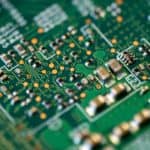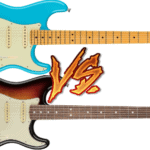I have a friend who builds guitars as a hobby, he’s not a luthier, but he’s able to make a working instrument.
A lot of his guitar shapes are based on existing designs from brands and he uses the guitars for himself, but is he risking a lawsuit?
Under the law, once a guitar design is patented, copying that design for anything more than personal use is illegal. Most body shapes, other than LPs and Strats aren’t trademarked though, or at least haven’t been defended in court. Headstock shapes, however, are usually trademarked and defended.
So that makes you wonder, what can you copy when building a guitar for sale purposes, and is it a matter of walking on eggshells, or is it the same as music labels trying to copyright chord progressions?
Copyright vs trademarks
Let’s start by breaking down the difference between copyright and trademarks.
A trademark is a type of intellectual property, it’s usually a recognized sign, design, or expression that distinguishes a certain product or brand from others. A trademark can be owned by an individual business or a legal entity.
Copyright is the exclusive and assignable legal right, given to the owner of a material or product to make, copy and sell their product. This is given for a fixed term by law and gives the owner the right to use their product in whatever way they deem fit.
A trademark distinguishes a product from others in the same category and copyright is the right to produce that product.
In this sense, taking a fender Stratocaster and putting a different name on it would be infringing on its copyright because it’s the same product.
Making a guitar of your own and naming it under the Fender brand would be fraudulently using a trademark to improve your own sales.
Both examples are illegal.
Are guitar body shapes free to use?
Most guitar body shapes are free to use because a lot of designs are both standard and part of the public domain already.
Something becomes part of the public domain when it exists for an amount of time without being copyrighted or trademarked. It’s mainly because launching an Intellectual Property lawsuit is extremely expensive and usually not worth it.
Gibson tried to trademark their single-cut body design back in the day, but they failed because there were already too many other single-cut designs out there. Most brands do tend to trademark headstocks or logos though.
Are guitar model names restricted to use?
Yes. A lot of big companies have trademarked their names. Fender and Gibson have trademarked a lot of their most iconic guitar models. That’s why copy guitars usually have T-style written rather than telecaster.
Rickenbacker guitars have trademarked not only their names but are one of the few guitar brands that also managed to trademark their designs all the way through. It’s really about jumping on the paperwork as soon as possible.
A side note about trademark and copyright infringements; being that defending them is so expensive, most of the time big companies win against small companies, even if their remarks are unfounded.
How come many brands use Fender’s original shapes?
Fender tried to undo this a few years ago, trying to trademark their TELE and STRAT body shapes. The problem was that there were already so many copy guitars out there that their design was no longer distinguished.
Fender simply waited too long to do this, and so they lost that battle in court because a whole slew of smaller guitar makers argued against it. Fender had to retract their claims and so we still have access to copy makes that are a lower price than Fender guitars. Yay for us.
Are guitar neck shapes free to use?
Guitar neck shapes are generally the same in design and shape, this is because the guitar neck shape is mainly functional. It’s the main part you play on, so it has to be standard and ergonomic.
The main thing that substantiates a trademark claim is whether it’s a functional part or a cosmetic distinction. If something is functional for a product to work, it generally can’t be trademarked.
The same goes for the fretboard. Frets are functional and mathematically spaced, so you can’t trademark or copyright that. The inlays and designs are commonly trademarked, however, as those are purely cosmetic additions to the guitar neck/fretboard.
Why are guitar headstocks not that commonly copied?
Headstocks are a hybrid of aesthetics while also being a functional part of the guitar. The main functional parts of a headstock are the tuning pegs. Other than that, the design is cosmetic.
The Fender Stratocaster headstock is a good example of a trademarked headstock. You can’t copy it because it’s aesthetically unique, although I do know of some smaller brands who’ve copied the strat headstock and got away with it for a time.
SX guitars made a copy of Fender Strats and in early models, they copied the headstock too. They still do for Eastern country production but have at least stopped on the headstock design for the Western market.
What are other patented parts of a guitar that can’t be copied?
Well, there are the obvious ones like the Floyd Rose bridge design. While it’s a functional part of the guitar, it’s unique and there are many alternatives to it.
There are copies of the Floyd Rose on the market, but they’re not exact.
The bridge design is sometimes patented on instruments. It’s similar to the headstock in that it’s functional but doesn’t need to be ergonomic.
There are patents for guitar body designs, it’s not to say that the body of a guitar has never been patented, the reason Fender and Gibson failed is that their designs were already part of the public domain.
Other patents are for unique functionality, like foldable guitars, electronic fretboards, interchangeable part designs, and so on.
It would seem that the only parts of the guitar that can’t be patented are the parts that directly affect the player’s ability to use the guitar. That would be the neck of the guitar most of all as your left hand needs to be able to move up and down it smoothly.
The design for the guitar neck hasn’t changed for a very long time aside from some small variations in width and slight curvature.
Would you be in trouble if you make a one-off guitar replica?
The key here is that your replica can’t be used for profit or gain. If you’re a hobby guitar player and you want to make a replica that you wish to make personal use of, it’s unlikely you’ll face legal action.
The problem of copyright lies in producers and professionals recreating each other’s work for profits so if you want to make a replica guitar and you can find custom parts, you’ll likely be able to build it.
The only catch would be that you couldn’t try to publicize your replica copy in any way.

Hello there, my name is Ramiro and I’ve been playing guitar for almost 20 years. I’m obsessed with everything gear-related and I thought it might be worth sharing it. From guitars, pedals, amps, and synths to studio gear and production tips, I hope you find what I post here useful, and I’ll try my best to keep it entertaining also.





